Silver Ores and
Silver Bearing Minerals |
|
|
Gold and silver are obtained from a variety of
ores, in some of which the gold predominates, in others silver is the primary
value, while in still a
third class these two metals may be mixed with the base metals, such as lead,
copper, zinc, and iron. Few silver ores are absolutely free from gold, and vice
versa, so that a separate consideration of the two is more or less a difficult
task. For ores where the most valuable element is silver, the silver is normally
contained in minerals colored gray to black in appearance. These minerals range
from a metallic sheen to an earthy soot-like appearance. Sooty black minerals
are common in many very rich silver ore samples. Most of these sooty black
deposits consist of acanthite or various complex silver sulfides.
The most common valuable minerals which may
constitute rich silver ores include
native silver;
acanthite
(silver sulfide);
pyargyrite (dark ruby silver or silver antimony sulfide);
Proustite (light ruby
silver or silver arsenic sulfide);
Stephanite
(brittle silver, also a silver
antimony sulfide);
Polybasite (also a silver antimony sulfide);
Cerargyrite
(Silver Chloride); Bromyrite (silver bromide) and Iodyrite (silver Iodide).
Bonanza grade silver ore can also contain various silver telluride minerals
including
Calaverite,
Sylvanite and Hessite. To a lesser extent, base metal
sulfides including
Galena,
sphalerite,
pyrite,
chalcopyrite, and chalcocite may
all be and frequently are argentiferous, but in most silver ore deposits, the
silver is most concentrated in the minerals of the group first named. Of the
base metal ore minerals, the most common primary ones are argentiferous galena,
sphalerite, and pyrite, while native silver and the sulphides and arsenides are
less common. |
|
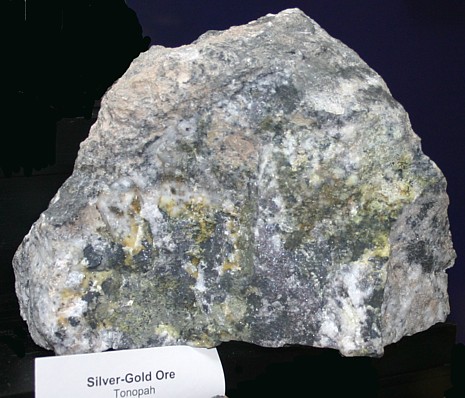 |
Rich silver ore from the town of Tonopah in Nye county Nevada.
Tonopah was one of the great epithermal silver and gold strikes of the early
20th century. The bonanza ore is rich in silver sulfides and also contains
some free gold as well. Dark colored minerals of an almost sooty appearance are
rich in silver. |
|
|
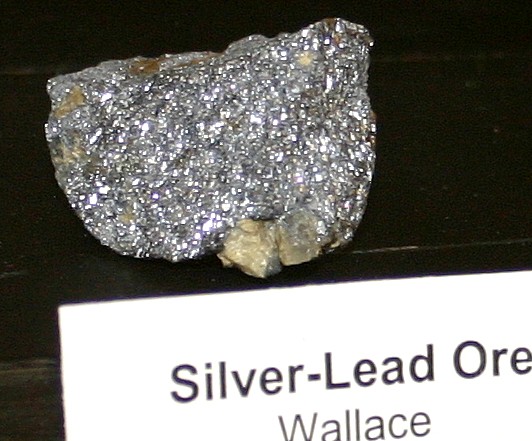 |
Rich
lead - silver ore from the famous mines of Wallace, Idaho. These mines have
been mined to very deep levels below the surface. |
|
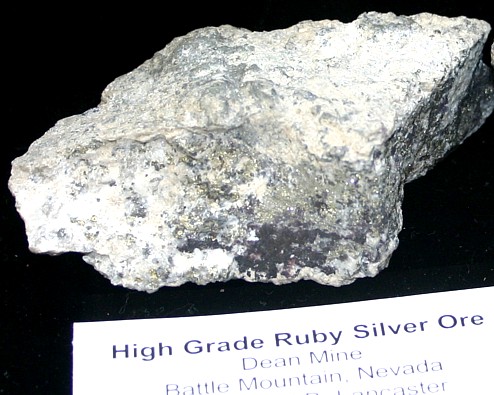 |
Dark
colored high grade ruby silver ore (pyrargyrite) from the rich Nevada Mines
at Battle Mountain in Lander County. Although Silver was the first metal
discovered here, Battle Mountain has also produced a significant amount of
both gold and copper ore as well as silver. |
|
|
|
|
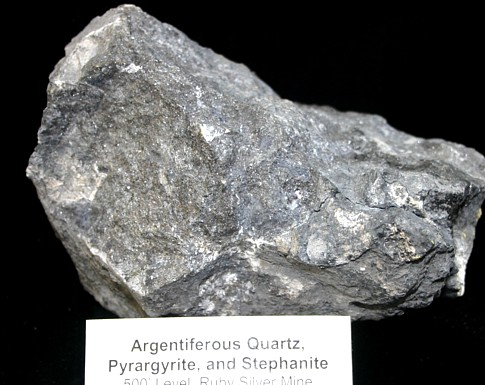 |
This
sulfide rich silver ore from Nevada is dark gray and colored by a heavy
content of metallic sulfides. The rich silver minerals pyrargyrite and
stephanite boost the silver content of this bonanza grade ore. |
|
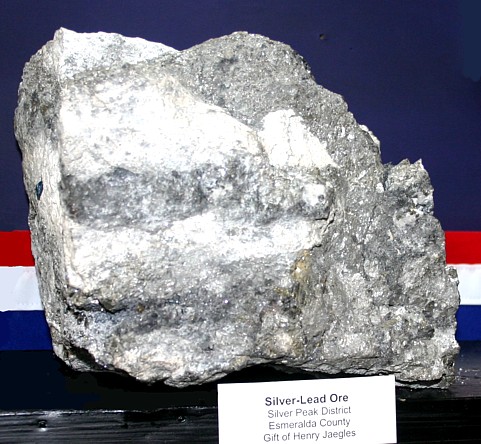 |
The Silver Peak mining district in Esmerelda County, Nevada was very productive in
the late 1800s, but work continued through the early 1900s, and is still a
site for ongoing open pit gold mining to this day. This area produced many millions of dollars from
silver ore which looked like
this specimen. It is colored gray by rich silver and lead sulfide minerals. |
|
|
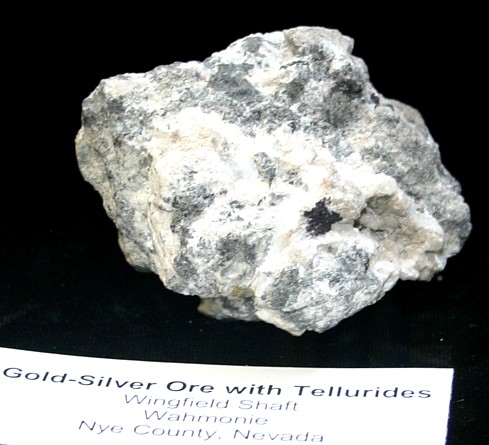 |
This
bonanza grade silver ore is from Nye County in Nevada. As with a number of
the samples, the sooty black minerals are rich in silver. It also contains
silver tellurides. |
|
|
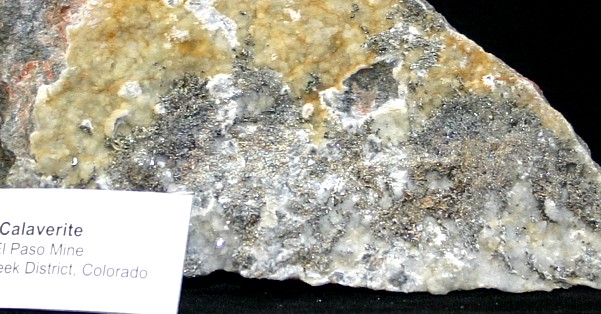 |
Telluride
minerals such as calaverite, are also important silver ores in some mining
districts. This sample of rich gold and silver ore comes from the
Cripple Creek district in Colorado. The mossy metallic colored mineral
on this specimen is calaverite, a mineral rich in both gold and silver. |
|
|
|
|
|
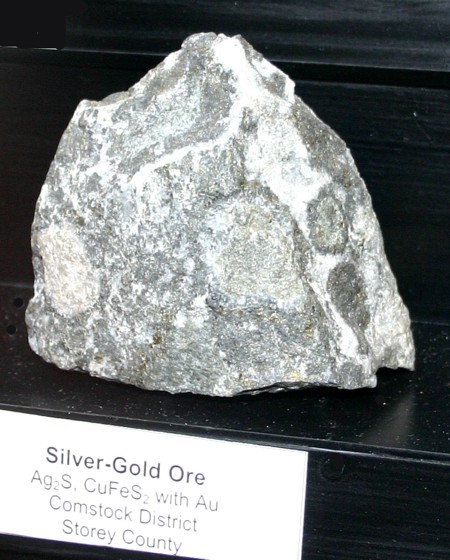 |
The
Comstock lode district was perhaps the largest single silver ore find ever
made in the USA. The Comstock lode is famous for its ore bodies of bonanza
grade silver ore rich in sooty silver sulfide minerals like acanthite
(formerly known as argentite). The ore also contains considerable other
sulfide minerals and some free gold as well.
The Comstock is famous for great
bonanzas of crushed, mineralized quartz, in part exceedingly rich in silver
minerals, were found at intervals along the lode, especially in chambers or
vertical fissures probably produced by normal faulting of the hanging wall.
The ores consist of quartz and some calcite, in places banded with pyrite,
galena, chalcopyrite, sphalerite, and finely distributed rich silver
minerals. The valuable minerals are mainly native gold,
acanthite (argentite), stephanite, and polybasite.
|
|
|
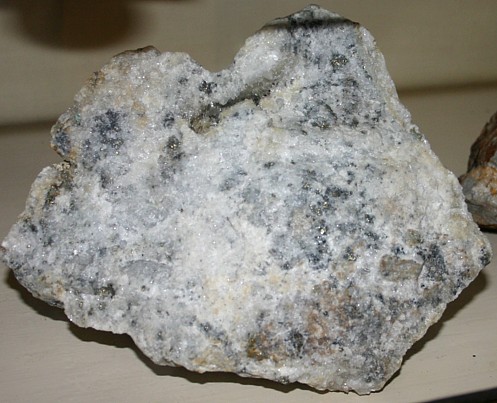 |
Virginia City silver ore:
This
is another sample of bonanza grade rich silver ore from the Comstock lode in
northern Nevada near Reno. Rich silver sulfides like acanthite and
polybasite, together with base metal sulfides like pyrite, galena and chalcopyrite
are sprinkled though quartz and adularia feldspar vein material.
Virginia City is
still an interesting attraction for tourists in mining for silver was
conducted through the 1980s. |
|
 |
Austin, Nevada, in the central part of the state, was known for its high
grade silver ores which occurred in a network of narrow veins. The district
produced many millions of dollars worth of silver during the mid to late
1800s. The oxidized surface ores like this sample shown here were easy for
the miners to process. However, the deep ores, which contained a large
percentage of base metal sulfides was very difficult for the miners to
process and extract the silver. Eventually new technology and methods were
developed to capture the silver out of the rich deep ores. |
|
|
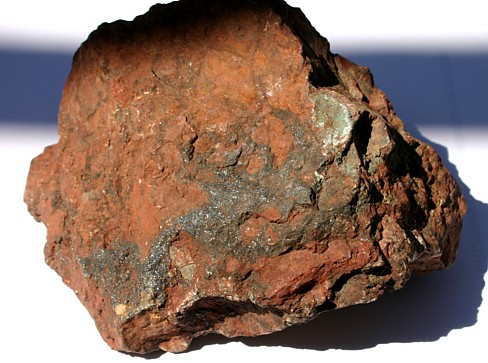 |
Calico
Silver Ore
In the Calico District, deposits of silver chloride in
fissure veins, and in small fractures and pockets in volcanic tuffs and
sandstones, probably of the Pliocene series. Below the oxidation zone, rich
chlorides give way to silver bearing sulfides as shown in this specimen.
They occur in Southwestern California, in that portion of the State
belonging to the Great Basin geologic province. The
ore was thought by Lindgren to
have come in heated solution from
below and to have filled the fissures and overflowed,
forming the surface deposits in the tuffs. They are considered epithermal in
origin.
|
|
|
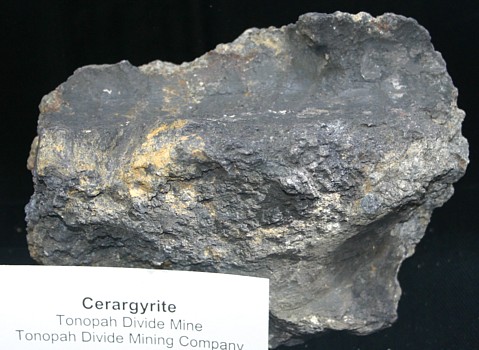 |
The sooty black colored material in this specimen is
cerargyrite, an important ore of silver. In many deposits located in
desert regions, silver sulfide minerals like acanthite (argentite), stephanite, and polybasite
or oxidized by exposure to air and
water into a
silver chloride, also known as
cerargyrite. as a result, this type of silver ore is only found near the
surface. Once miners get down below the water table, this type of
mineral and ore will disappear and only sulfides will be found in its place.
This rich specimen was taken from the Tonopah Divide mine, in the Divide
district of Nye County, Nevada. |
Recommended
Metal Detectors
For Gold Prospecting:
|
|
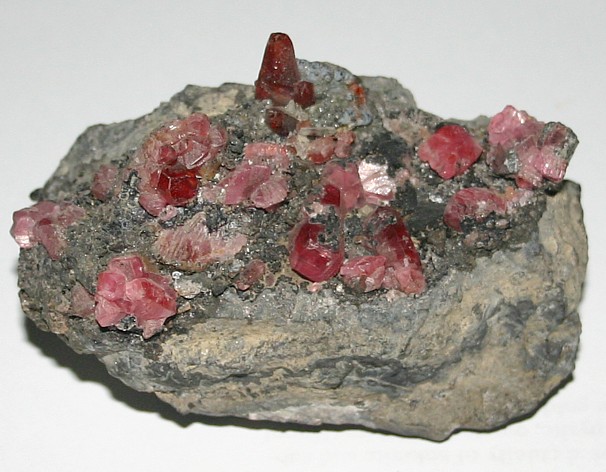 |
Rhodochrosite and silver ore, Peru:
This beautiful specimen
of silver ore comes from the country of Peru in South America. The dark
colored minerals are the ones which are silver bearing, while the red and
pink colored crystals are
Rhodochrosite, a common manganese mineral that is found in a number of
silver ores. |
|
|
|
Standard Types of Silver
Ores:
There are two general classes of silver ore that
have been mined: 1) lead-silver and 2) high-grade silver ores. Both have almost
always varying amounts of gold. The lead -silver mines furnish also, as noted
above, by far the greater portion of the lead produced in the United States.
High grade silver ores normally have considerably less base metal content and
often contain significant gold.
1.
Dry or Siliceous Ores. These include: (a) The
gold and silver ores proper, including bonanza epithermal silver ores; (b)
fluxing ores carrying considerable quantities of iron and manganese oxides with
small gold and silver contents; (c) precious-metal bearing ores with copper,
lead and zinc in small amounts; and (d) disseminated low grade silver deposits.
The states of Colorado, California, Nevada, South Dakota, and Alaska have been
the largest producers of this category of silver ore The siliceous ores are in
part free milling; in part simply concentrating, as parts of Colorado and
Arizona; in increasing part all-sliming and cyaniding; and in part smelting. A
great deal of the silver from the gold-silver siliceous ores is obtained with
the gold by cyanidation, the silver being recovered by refining the mill
bullion. The remainder is obtained by smelting rich ores and refining copper or
lead bullion produced. The siliceous silver ores are of varying age, but most
epithermal ores are young, typically post-Miocene age. Those found chiefly in
Colorado, Nevada, and Montana, are associated with Tertiary lavas and
characterized by Bonanza grade rich ores. Some of the most productive ones may carry
fluorite and normally also tellurides. In some the value of the
gold may
predominate; in others, silver.
2.
Copper ores, usually with over 1 per cent
copper, but with less in the case of the western disseminated ores and those of
Lake Superior. The largest gold producers are those of Utah, Arizona, Nevada,
and Montana. The silver production comes from the electrolytic refining of
blister copper produced by smelting. The great disseminated deposits of Utah,
Arizona, Nevada, and New Mexico are yielding increasing quantities, while the
vein deposits of places like Butte, Mont., have are also been important. The
gold- and silver-bearing copper ores exhibit great differences in form and age;
neither do all the occurrences yield much gold or silver, and, moreover, they
are of more importance as gold producers, silver being less often associated
with the copper.
3. Lead-bearing Silver ores: These
are silver ores containing 4 percent or more of lead. The silver comes mainly
from the lead-silver ores of Coeur d'Alene, Idaho, Utah (chiefly Park City and
Tintic), Colorado (Leadville and Aspen). Most of the output is obtained by the
de-silverization of lead bullion using molten zinc.
The silver and
lead ores form a large class, of
rather wide distribution, and while the two metals characterizing the group are
the most prominent, there may also be, and often is, present a variable quantity
of other metals such as gold, zinc, and copper. The silver contents, though
sometimes high, but are not necessarily visible, and may be contained within the
galena as Ag2S partly replacing lead sulfide in the crystal. The ore bodies as a
whole present a variety of forms, the ore having been deposited either by
fissure vein cavity filling or replacement, or both. Most of the important
occurrences seem to have been formed at intermediate depths. Oxidation zones
frequently cap the ore bodies, and downward secondary enrichment has probably
occurred in many cases.
Silver-lead ores form a widely
distributed class in the Cordilleran region of the United States and supply most
of the lead mined in this country. Prominent deposits have been mined in
Colorado, Idaho, and Utah, but are also known in New Mexico, Montana, Wyoming,
Nevada, Arizona, California, and South Dakota.
Canada
supplies a small but steady production from British Columbia, while in other
foreign countries districts worth noting for either commercial or historic
importance are Broken
Hill, New South Wales, Australia;
Clausthal and Freiberg, Germany; Przibram, Bohemia; Sala, Sweden; Laurium,
Greece; Mexico, etc.
4. Copper-lead or Copper-lead-zinc
Ores. These are unimportant as compared with
the others. The gold they supply is small, and the main silver production was from
mines in
Colorado and Nevada. Historically, the Eureka district in Nevada yielded
significant amounts of copper-lead-zinc ore with large amounts of gold and
silver. They are often designated as polymetallic ores in modern classification
systems.
5.
Zinc ores, containing at least 25 per cent
zinc. These yield little gold, and the silver which is obtained mainly as a
by-product from the smelting of
zinc ore concentrates and in the US has been
obtained chiefly from deposits in Nevada, Montana, and Arizona.
If you haven't seen my
original crystal nugget page, beautiful nugget photos:
CRYSTAL GOLD NUGGETS
A second page of
beautiful nugget photos:
GOLD AND PLATINUM NUGGETS
I also have a page of
beautiful Gold Ore Specimen photos:
GOLD ORES AND MINERALS
For more information on
gold vein ores, check out my page of
CALIFORNIA MOTHER LODE GOLD QUARTZ VEINS
To learn about the
minerals that produce copper, check my page of
COPPER ORES AND MINERALS
Please note these
specimens are not for sale, most are not owned by me. I present this page as a
reference, as folks just love to look at real natural beauty and these silver
ore
specimens are definitely that. Photographs and text are copyrighted
and may not be reproduced without permission.
Gold Nugget, Gold Fever, Gold Prospecting, Gold
Panning, Gold detecting, gold flakes, gold dust, gold jewelry, gold crystals,
gold bullion, gold coins, gold bars, gold mine, gold digger













